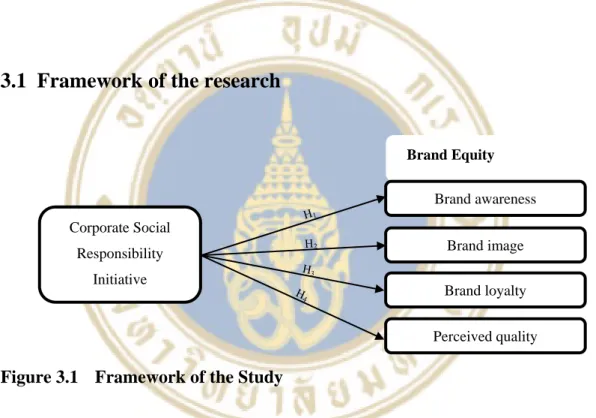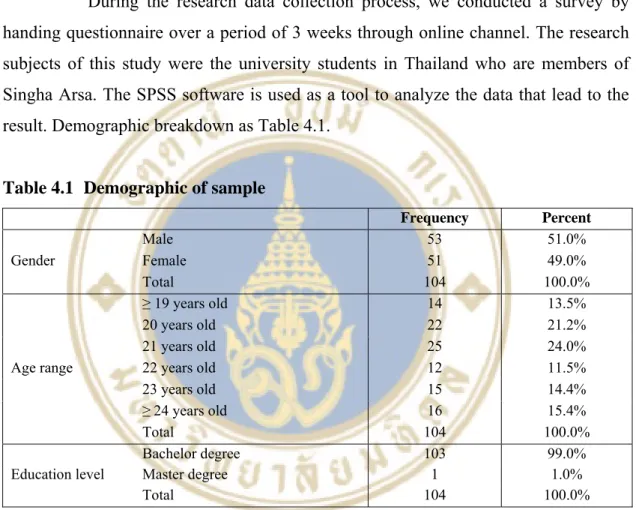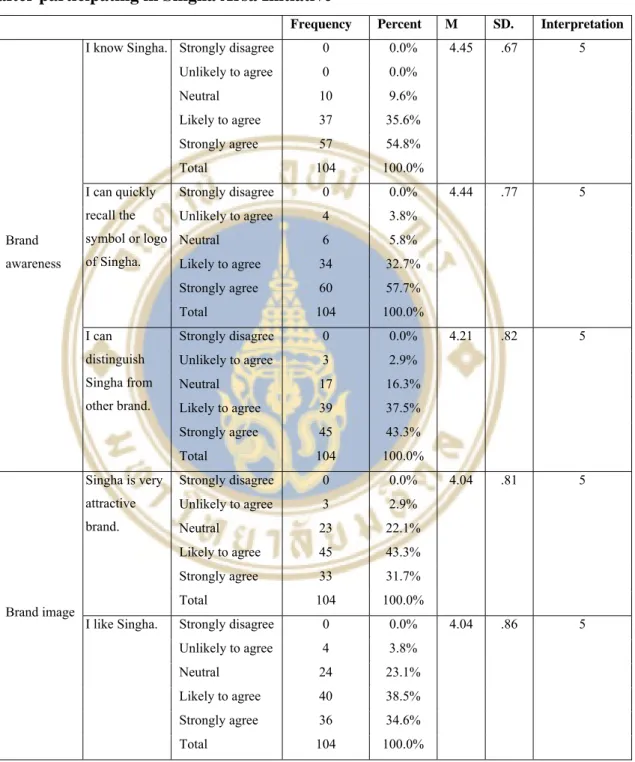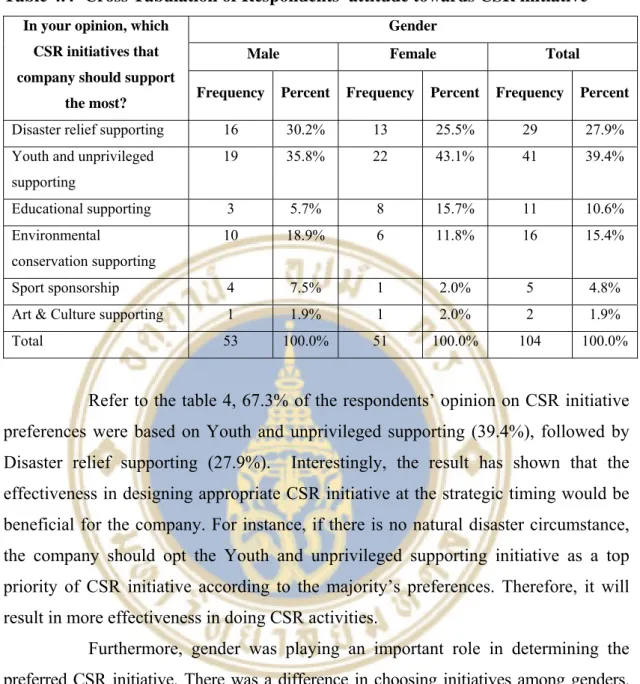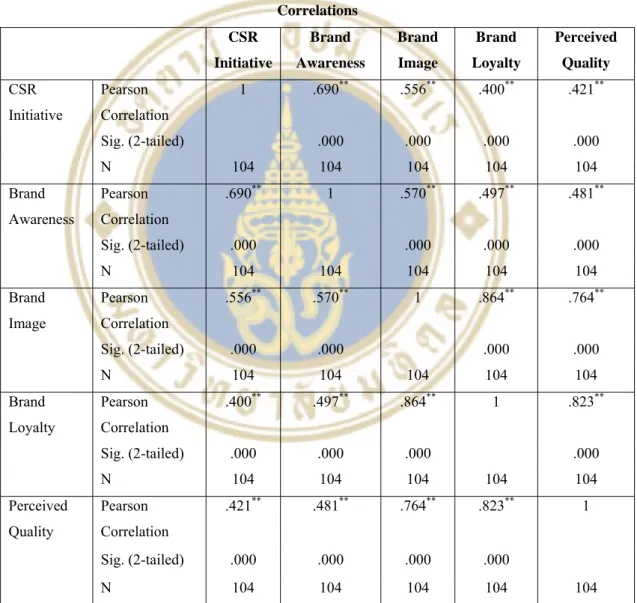The purpose of this research is to examine the impact of CSR initiative on brand equity in the alcohol industry in Thailand. The research was conducted using a quantitative research approach by distributing 100 respondents who are Singh Ars members across Thailand. The main finding of this research showed that CSR initiative can affect the overall brand equity.
Corporate Social Responsibility (CSR) has been a much discussed topic since the 19th century and has become a major global issue (Hopkins, 2003). Due to the fact that the Singha CSR initiative has been established for over 6 years, the main focus of these initiatives is to support the environmental and social aspect. The Singha Arsa initiative partners with a number of universities throughout Thailand and the main target group is mostly undergraduate students.
But does it really contribute to Singha's brand equity and can CSR initiative cripple negative association with the brand. The study examines whether CSR initiatives can increase Singha's brand equity after Singha Arsa members participate in Singha CSR initiatives. The purpose of this study aims to investigate the relationship between Singha Corporate Social Responsibility (CSR) initiative and brand equity among the respondent's profile.
The scope of the research will focus on the impact of CSR on overall brand equity and its dimensions: brand awareness, brand image, brand loyalty and perceived brand quality of Singha.

Expected Benefits
LITERATURE REVIEW
- Corporate Brand Trust as Mediator in the Relationship between Consumer Perception of CSR, Corporate Hypocrisy, and Corporate
- Corporate Social Responsibility, Perceived Customer Value, and Customer-Based Brand Equity: A Cross-National Comparison
- Impact of CSR Perception on Brand Image, Brand Attitude and Buying Willingness: A Study of a Global Café
- Measuring Brand Equity across Products and Markets
- The Influence of Corporate Social Responsibility on Brand Equity Corporations have included and implemented CSR initiatives to fulfill
CSR managers must therefore consistently monitor whether their CSR initiatives have increased the level of trust in the company's brand (Kim, 2015). The paper reflects on the impact of CSR efforts on the success of a company by focusing on two main marketing variables; Customer Perceived Value (PCV) and Customer Based Brand Equity (CBBE). The result showed that if the level of CSR efforts is perceived as high, the level of CBBE is also affected more positively than if CSR efforts are perceived as relatively low.
Furthermore, the results support the existing effect of CSR efforts on PCV with all its hard and soft dimensions. In addition, the study's two conceptual frameworks indicate that the level of perceived CSR effort directly affects CBBE and indirectly affects PCV through CBBE. Therefore, investments in CSR efforts result in returns for both CBBE and PCV, but PCV is further enhanced by an increase in CBBE (Simone, 2014).
Also the research found that a business that undertakes its CSR policy can induce consumers to buy its products. In this article, the author aims to explain the measurement effects of brand equity with products. The article further explains that if organizations measure brand equity, they can have significant practical value in doing so and can enhance a firm's ability to manage a portfolio of brands and markets and develop a valid equity measurement system. of the brand.
The author used five measurements and proved that by performing CSR activities, a firm can improve its brand equity. There is evidence that CSR initiatives benefit not only corporations and brands, but also communities and consumers. Aaker (1991) incorporated both perceptual and behavioral dimensions into the concept of brand equity.
Brand awareness, brand image, perceived quality and brand loyalty were the five dimensions of brand equity. According to the theoretical framework for brand equity, there is no direct relationship between CSR initiatives and brand equity. However, the correlation between CSR and brand equity can be separated into five variables as independent variables and their subsequent impact on brand equity as dependent variable.
RESEARCH METHODOLOGY
Framework of the research
Research Design
Data Collection Methodology
- Population
- Sampling
- Data Collection
The sample size was 53 male respondents and 51 female respondents who are undergraduate students and have participated in activities of the Singha Arsa initiative. The research approach was the online closed-ended questionnaire due to the short data collection period and ease for respondents to access the questionnaire. The reason for excluding the introductory question is that the survey is being conducted among respondents who were already aware of Singha CSR initiatives.
In this part, respondents will be asked for their opinion on various aspects, and Likert scales are used to measure the level of agreement or disagreement. Questions will cover the following: brand awareness, brand image, brand loyalty and perceived quality. The online questionnaire will be distributed on the Singh Ars website and Facebook group containing the target respondents.
While correlation is used to determine the relationship between brand equity and CSR initiative. In addition, a cross-tabulation is used to show the different preferences for CSR initiatives between genders. In addition, these will help to find the result of the impact of the CSR initiative on the brand equity structure.
RESEARCH FINDINGS AND DISCUSSION
- Association between CSR initiative and the brand equity
- The level of brand equity after participating in Singha Arsa initiative
- Cross tabulation of Respondent’s attitude towards CSR initiative The research further investigated into the difference in preferences between
- Correlation analysis
- Final Framework of the research
The descriptive analysis is described below: The result showed that most of the respondents know that Singha Corporation manages CSR initiatives under the name "Singha Arsa" (M .99, SD .10). Respondents also agreed that the Singh Ars initiative is very active in contributing to the betterment of society (M .97, SD .17). In addition, almost all respondents believe that Singh's CSR initiative emphasizes philanthropy-related activities such as supporting money for charity (M .90, SD .30).
In terms of Table 3, the result has shown that the attitude of respondents towards Singha CSR initiative in different dimensions of brand equity. Overall, Singha's CSR initiative was effective in creating Brand Awareness, Brand Image and Perceived Quality. In other words, brand loyalty is unlikely to be gained by initiating a CSR initiative in a short period of time.
Moreover, the CSR initiative has effectively impacted the brand awareness of the Singha Arsa members who participated in activities. In terms of brand image, the result reflected that the majority of respondents were likely to agree that CSR initiatives can improve their brand attractiveness attitudes (SD.81) and that they personally like the brand (SD.86) , but that was not the case. contribute to an increase in brand loyalty. See Table 4: 67.3% of respondents' views on CSR initiative preferences were based on support for youth and the disadvantaged (39.4%), followed by support for disaster relief (27.9%).
Interestingly, the result showed that the effectiveness of designing an appropriate CSR initiative at a strategic time would be beneficial to the company. For example, in the absence of a natural disaster, a company should choose an initiative to support the youth and the underprivileged as the top priority of a CSR initiative based on the wishes of the majority. Ultimately, for each variable that was tested, the result showed that each brand equity variable was associated with CSR initiative.
The result showed that the relationship between the CSR initiatives and brand awareness is highly significant at r α .690**, p-value 0.01. The result showed that the relationship between the CSR initiatives and brand image is highly significant at r α .556**, p-value 0.01. The result showed that the relationship between the CSR initiatives and brand loyalty is significant at r α .400**, p-value 0.01.
The result showed that the relationship between CSR initiatives and perceived quality is significant at r α .421**, p-value 0.01. The research used correlation to examine the relationship between CSR initiative and brand equity and the result is shown in figure 4.1.
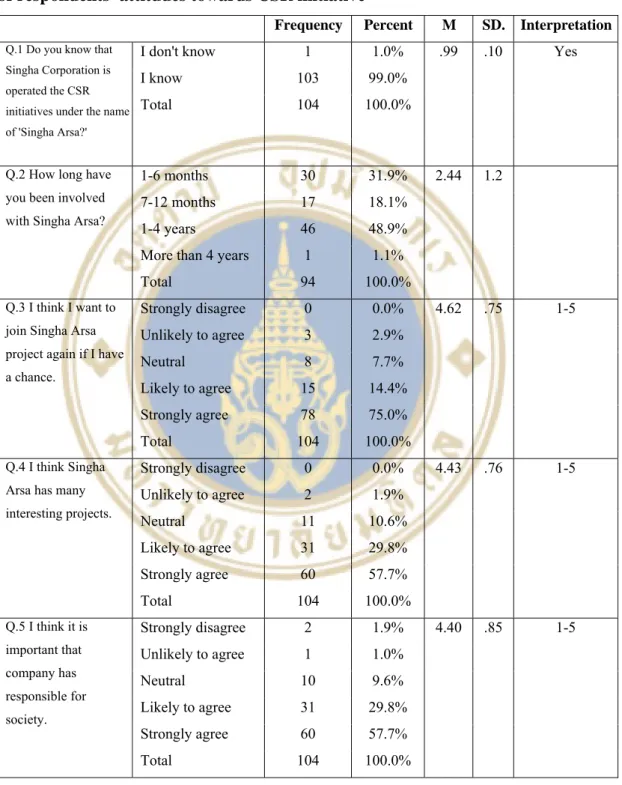
CONCLUSIONS
- Conclusions
- Discussion
- Recommendations
- Managerial Implications
- Limitations and suggestions for future research
The researcher designed the survey to evaluate the relationship between CSR initiative and brand equity among the students who participated in the CSR initiative activity. The result of the data analysis shows that the CSR initiative helps in increasing the brand value and its dimension for the Singha brand. If the company can initiate more appropriate CSR initiative activities, it would be attractive for the target group to participate in the activity.
So the result showed that the more they are involved in the activity, the more the brand value will increase. Singha CSR initiative can completely improve brand awareness, brand image and perceived quality other than brand loyalty. Therefore, the company could redesign the initiative that can increase brand loyalty within consumer attitudes.
In order to implement and design the CSR initiative, the company should engage in activity that matches gender preferences. If the company should be well planned in the design of the CSR activity and the willingness to recruit volunteers, this would result in a greater consistency in joining activities that can increase brand equity. In addition, the manager should increase brand loyalty by using loyalty program such as membership card for Singha Arsa members to get privileges in purchasing Singha products.
Not only will it create brand engagement with customers, but repeat purchase of the brand they are loyal to. From the research findings, if the company can start the right CSR activity that matches the target group, especially the university students, it would result in more participants, which can promote brand awareness and eventually lead to other factors. important that can improve the brand. Moreover, the finding is very constructive for the manager to understand the target respondents deeply.
Furthermore, the manager can be assured that the finding is proven that the brand equity can certainly be affected through the CSR initiative. Conducting interview (qualitative method) to gain a deeper understanding regarding brand equity and purchasing behavior after participating in CSR activity. To study the impact of CSR initiative towards brand equity, future research should conduct the survey before and after the CSR initiative activity in order to gain more accurate results.
APPENDICES
Appendix A: Questionnaire
Consumer's perception of brand equity after received or participated in Singha Arsa initiatives
Demographic Information

